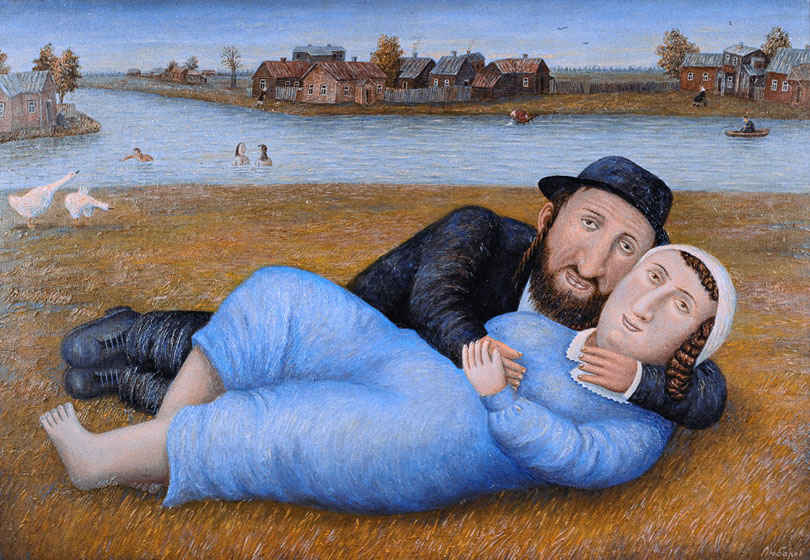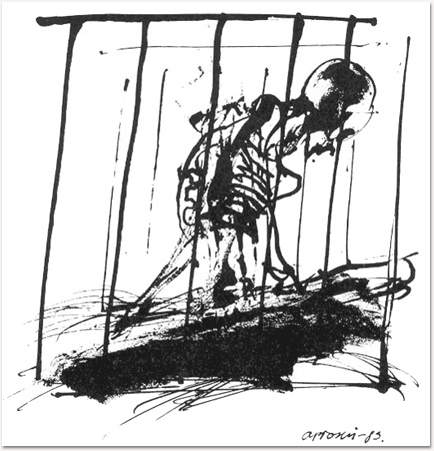…Staring dumbly through the glass. At a base level, it is amoral, as interested in invoking destruction as in positing creation. There he is, in a glass cage, dreaming of the supernormal solution and giving off the vibe of misery, pain and emptiness, summoning up cruel powers and hoping they will concentrate towards some kind of bliss. The perception of escaping being nailed down under dots, ritual gestures and letters, under the holy fringes of everything and all finds itself seeking respite from a psychic epidemic , a cultural landslide inside the glass cage. The collapse of the traditional way under the pressure of all that it had been developed to keep at arm’s distance. Such ideological chaos that post-modernism foisted upon us is both revolutionary moment and the burden of finding the new Law. Until then, the default position of suffering and what if not Jewish suffering, as jagged metaphor for the overall human condition: we are born to struggle, though perhaps for the Jews a bit more of a burden. The curse and responsibilities of the five books of Moses. Is our human condition to suffer and cause suffering as we work through the minefield that shrouds and detonates the linksbetween personal identity and assimilation. The jew in the glass box, as artifact from the past, stuffed and mounted and conversation piece of an enduring narrative of the human capacity to foster hatred towards those who are different, and jews at the nexus of the conflict between a braod melting in and vanishing into the dominant culture, like another paint drop in a Jackson Pollock, and opposed to a stubborn resistance on the behalf of those not willing to relinquish…
( see link at end)…“Are there still Jews in Germany?” ”Are the Jews a chosen people?“
Nearly 70 years after the Holocaust, there is no more sensitive an issue in German life as the role of Jews. With fewer than 200,000 Jews among Germany’s 82 million people, few Germans born after World War II know any Jews or much about them.
To help educate postwar generations, an exhibit at the Jewish Museum features a Jewish man or woman seated inside a glass box for two hours a day through August to answer visitors’ questions about Jews and Jewish life. The base of the box asks: “Are there still Jews in Germany?”…

—Adam and Eve. From the series “Jewish happiness”
Artist
Vladimir Lubarov
Category
painting
Material
canvas
Technics
oil—click image for source…
…But not everybody thinks putting a Jew on display is the best way to build understanding and mutual respect.
Since the exhibit — “The Whole Truth, everything you wanted to know about Jews” — opened this month, the “Jew in the Box,” as it is popularly known, has drawn sharp criticism within the Jewish community — especially in the city where the Nazis orchestrated the slaughter of 6 million Jews until Adolf Hitler’s defeat in 1945.
“Why don’t they give him a banana and a glass of water, turn up the heat and make the Jew feel really cozy in his glass box,” prominent Berlin Jewish community figure Stephan Kramer told The Associated Press. “They actually asked me if I wanted to participate. But I told them I’m not available.”…
…The exhibit is reminiscent of Holocaust architect Adolf Eichmann sitting in a glass booth at the 1961 trial in Israel which led to his execution. And it’s certainly more provocative than British actress Tilda Swinton sleeping in a glass box at a recent performance at the Museum of Modern Art in New York.

—One day the cage of the Hunger Artist falls into obscurity until the circus manager happens to notice it. His employee pokes into the straw to learn that the artist is still there. The artist apologizes to the manager and explains the reason why he’s fasted for all his years, then dies. A panther replaces the cage and is fed the food of its choosing, and lives vibrantly before a crowd that is eager to watch.—Kafka
…Eran Levy, an Israeli who has lived in Berlin for years, was horrified by the idea of p
nting a Jew as a museum piece, even if to answer Germans’ questions about Jewish life.“It’s a horrible thing to do — completely degrading and not helpful,” he said. “The Jewish Museum absolutely missed the point if they wanted to do anything to improve the relations between Germans and Jews.”
But several of the volunteers, including both German Jews and Israelis living in Berlin, said the experience in the box is little different from what they go through as Jews living in the country that produced the Nazis.
“With so few of us, you almost inevitably feel like an exhibition piece,” volunteer Leeor Englander said. “Once you’ve been ’outed’ as a Jew, you always have to be the expert and answer all questions regarding anything related to religion, Israel, the Holocaust and so on.”
…Museum curator Miriam Goldmann, who is Jewish, believes the exhibit’s provocative “in your face” approach is the best way to overcome the emotional barriers and deal with a subject that remains painful for both Jews and non-Jews….
The provocative style is evident in other parts of the special exhibition, including some that openly raise many stereotypes of Jews widespread not only in Germany but elsewhere in Europe.
One includes a placard that asks “how you recognize a Jew?” It’s next to assortment of yarmulkes, black hats and women’s hair covers hanging from the ceiling on thin threads. Another asks if Jews consider themselves the chosen people. It includes a poem by Jewish author Leonard Fein: “How odd of God to choose the Jews. But how on earth could we refuse?”
Yet another invites visitors to express their opinion to such questions as “are Jews particularly good looking, influential, intelligent, animal loving or business savvy?”
Despite the criticisms, the “Jew in the Box” has proven a big hit among visitors.
…On a recent day this week, several visitors kept returning to ask questions of Ido Porat, a 33-year-old Israeli seated on a white bench with a pink cushion.
One woman wanted to know what to bring her hosts for a Shabbat dinner in Israel. Another asked why only Jewish men and not women wear yarmulkes. A third inquired about Judaism and homosexuality.
“I guess I should ask you about the relationship between Germans and Jews,” visitor Diemut Poppen said to Porat. “We Germans have so many insecurities when it comes to Jews.”
Viola Mohaupt-Zitfin, 53, asked if Porat felt welcome as a Jew living among Germans “considering our past and all that.”
“I feel a bit like an animal in the zoo, but in reality that’s what it’s like being a Jew in Germany,” Porat said. “You are a very interesting object to most people here.”
Dekel Peretz, one of volunteers in the glass box, said many Germans have an image of Jews that is far removed from the reality of contemporary Jewish life.
“They associate Jews with the Holocaust and the Nazi era,” he said. “Jews don’t have a history before or after. In Germany, Jews have been stereotyped as victims. It is important that people here get to know Jews to see that Jews are alive and that we have individual histories. I hope that this exhibit can help.”
Still, not everyone believes this is the best way to promote understanding.
Rabbi Yehuda Teichtal from the Jewish Chabad community in Berlin said Germans who are really interested in Jews and Judaism should visit the community’s educational centre.
“Here Jews will be happy to answer questions without sitting in a glass box,” he said….Read More:http://news.nationalpost.com/2013/03/29/provocative-exhibit-at-german-museum-that-puts-jews-in-a-box-to-answer-visitors-questions-draws-criticism/
P.S. Maybe the man in the box is the representative modern man of suffering, the symbol of exile from divine inheritance, in despair in the absurd Universe.Humans are deeper and more complicated than rational controls such as caging in glass boxes can keep hold of. Its a paradigm of the back to the wall choice, within this museum context, of affirming a mode of survival against steep odds. What else can keep the Jewish heart unified through over three thousand years of precarity as dissolved other nations within a few decades? There could be some divine hand in this resistance to demoralization and confusion, some technique, even alchemical of “creating” an Almighty and concept of Holy Joy where there seems visually at least, to be only emptiness and the wight of nihilism. Abandoned in a glass box, but still something blazing with life and actuality like a light that can never be extinguished.
ADDENDUM:
(see link at end)…The Jewbird, Bernard Malamud
…THE WINDOW WAS open so the skinny bird flew in. Flappity-flap with its frazzled black wings. That’s how it goes. It’s open, you’re in. Closed, you’re out and that’s your fate. The bird wearily flapped through the open kitchen window of Harry Cohen’s top-floor apartment on First Avenue near the lower East River. On a rod on the wall hung an escaped canary cage, its door wide open, but this black-type longbeaked bird—its ruffled head and small dull eyes, crossed a little, making it look like a dissipated crow—landed if not smack on Cohen’s thick lamb chop, at least on the table, close by. The frozen foods salesman was sitting at supper with his wife and young son on a hot August evening a year ago. Cohen, a heavy man with hairy chest and beefy shorts; Edie, in skinny yellow shorts and red halter; and their ten-year-old Morris (after her father)—Maurie, they called him, a nice kid though not overly bright—were all in the city after two weeks out, because Cohen’s mother was dying. They had been enjoying Kingston, New York, but drove back when Mama got sick in her flat in the Bronx.
“Right on the table,” said Cohen, putting down his beer glass and swatting at the bird. “Son of a bitch.”
“Harry, take care with your language,” Edie said, looking at Maurie, who watched every move.
The bird cawed hoarsely and with a flap of its bedraggled wings—feathers tufted this way and that—rose heavily to the top of the open kitchen door, where it perched staring down.
“Gevalt, a pogrom!”
“It’s a talking bird,” said Edie in astonishment.
“In Jewish,” said Maurie.
“Wise guy,” muttered Cohen. He gnawed on his chop, then put down the bone. “So if you can talk, say what’s your business. What do you want here?”
“If you can’t spare a lamb chop,” said the bird, “I’ll settle for a piece of herring with a crust of bread. You can’t live on your nerve forever.”
“This ain’t a restaurant,” Cohen replied. “All I’m asking is what brings you to this address?”
“The window was open,” the bird sighed; adding after a moment, “I’m running. I’m flying but I’m also running.”
“From whom?” asked Edie with interest.
“Anti-Semeets.”
“Anti-Semites?” they all said.
“That’s from who.”
“What kind of anti-Semites bother a bird?” Edie asked.
“Any kind,” said the bird, “also including eagles, vultures, and hawks. And once in a while some crows will take your eyes out.”
“But aren’t you a crow?”
“Me? I’m a Jewbird.”
Cohen laughed heartily. “What do you mean by that?”
The bird began dovening. He prayed without Book or tallith, but with passion. Edie bowed her head though not Cohen. And Maurie rocked back and forth with the prayer, looking up with one wide-open eye.
When the prayer was done Cohen remarked, “No hat, no phylacteries?”
“I’m an old radical.”
“You’re sure you’re not some kind of a ghost or dybbuk?” Read More:http://www.101bananas.com/library2/jewbird.html






 COMMENTS
COMMENTS